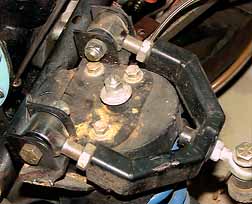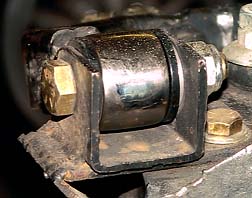
TR3 Suspension Mods Discussions
(Beyond the factory options)
> TeriAnn wrote: >
>I've spent a lot of time chatting with
TR3 & 4 racers about suspension.
>The short answer is you want a stiff front and a stockish rear
suspension.
>
>Almost no one is racing with a rear say bar on a TR3 because
it makes
>handling less predictable and it doesn't really help high speed
cornering.
For people not familiar with the early TRs, it might be worth
pointing out here that the TR2-4 (and some TR4A) are beam-axle
cars. Which means their handling (and what works to improve it)
is quite a bit different than the later IRS TRs. And, they have
a somewhat unique rear axle setup, with the axle going over the
frame, which introduces some unique twists in their handling.
Pushed to the limit, a stock TR2-4 will suddenly go from slight
understeer to gross oversteer when the axle hits the frame on
the inside rear wheel. Fortunately, once the outside rear tire
loses traction, the suspension unwinds and the inside tire plants
again, giving you another chance to recover instead of just instantly
tossing you over the high side. The net result is that the rear
ends 'skips' sideways.
IMO this effect is worth eliminating, even if it compromises
other aspects of handling. Thus, a heavy front bar, although it
induces more understeer, is desirable because it also helps keep
the axle from hitting the frame.
The beam axle TRs also have a quite stiff rear suspension, and
fairly drastically mismatched front and rear suspension roll centers,
which leads to lifting the inside rear wheel off the ground in
hard turns, even when it doesn't hit the frame. Again, you can
sacrifice some ultimate cornering force, in return for being able
to accelerate through the second half of the turn, and wind up
with a quicker car.
Randall
I had a long talk with a guy that used to race a TR3 in SCCA
during the late fifties and early sixties. He ran the factory
optional suspension parts, (factory front sway bar, comp springs
& shocks) and cheated at the rear.
According to him the trick was to add longer shackles to keep
the inside rear wheel on the ground longer and the axle off the
frame on hard corners. He made up a set of shackles that were
one inch longer than stock, shaped exactly like the stock ones
and then artfully reproduced the stock grunge so the SCCA tech
inspectors would not catch the longer shackles.
TeriAnn Near Santa Cruz, California
We started out with beautifully engineered track bars, rear sway
bar, and Panhard rod. The car was virtually unmanageable. We rented
a track for a test day and with each piece we removed, it handled
better. The same results were experienced by at least four other
TR racers in my circle of friends. I do use the rear spring locating
kit from BFE and have added one leaf to each rear spring, however.
We like the current handling.
uncle Jack Drews and Red, White and New Blue
--------
Below is from a TR3 front suspension thread
on the FOT mail list:
Wes Dayton wrote:
> Under our racing rules, we are allowed
to run up to 2 degrees of
> negative camber. After reading accounts from earlier FOT questions,
we
> have unsuccessfully attempted several mods (shortened upper
control arm,
> etc) but have been less than impressed with our results. One
problem is
> clearance of the ball-joint bolt/nut and the top of the spring
tower, etc.
>
> Yesterday we were looking hard at a TR6 front suspension that
just
> happened to be on the shelf. It would appear that we could use
the upper
> arms, vertical link and trunnion etc. We'd need to modify the
TR3A lower
> arm to accept the trunnion, but that looks to be pretty
> straightforward. It looks as though the 3A caliper plate would
still
> bolt up, etc. This would also appear to end up with a stronger
overall setup.
>
> Without going into any further details, maybe someone out there
has
> already "been there, done that" and has some advice/direction?
(Hope you brought your lunch for this answer.)
Been there, done that.
Last winter I purchased a front suspension software package
and spent many hours trying to find a way to provide negative
camber and improve the front end geometry in a practical manner,
using stock suspension pieces and pivots.
Maybe someone out there has come up with a nice improvement,
but I have not. However, I have successfully provided parts for
1-1/2 deg negative camber for a number of Triumphs. There are
three ways to do this that I know of, each with pro's and cons.
I hope that someone who has implemented a better solution than
what I'll describe will chime in and add to our collective knowledge.
One method is to weld internally threaded receptacles to the
upper a-arms in place of the current inboard ends, and install
Heim joints. It has pros and cons that you can imagine, one of
the cons being that it's illegal in most vintage circles to put
a Heim joint there, so I won't do it.
A second way is to bolt a piece of angle iron to the top of the
front tower where the trunnion is now bolted. Then you turn the
top trunnion 90 deg and bolt it to the vertical leg of the angle
iron, providing opportunity to shim between the trunnion and the
angle iron, for adjustability.
There is at least one TR in the Midwest using this approach and
it is successful. I like that idea, except it requires either
raising the pivot axis of the inner trunnion which makes theoretically
undesirable changes in the dynamics of the front suspension geometry,
or else you cut off two of the trunnion ears to get the pivot
line in about the right vertical position but that leaves only
two of those little ears holding the top trunnion on, which makes
me nervous.
The third way is one that I've either done myself or provided
parts for, now installed on maybe ten TR's that I know of. It
is not an original idea, lest anyone should be offended. This
involves using TR4 upper a-arms and shortening them.
For a TR4, This is pretty straightforward. You use all the stock
suspension members, saw a section out of the upper a-arms, and
weld them back together in a safe manner. I Mig weld them and
then weld another piece of steel to the open side of the c-section,
thus boxing in the joint, just for safety's sake.
For a TR3, you replace your current upper a-arms, upper ball
joints, and vertical link with TR4 parts. This gives you the TR4
caster angle, and it gives you upper a-arms that are more easily
shortened. The obvious disadvantage of this method is lack of
adjustability. That, plus you must saw the right amount out of
the upper a-arm, and that amount varies with the amount that you
have lowered your front suspension.
The combination that we're using on TR4's, and that should work
on TR3's, is to 1) Remove the upper aluminum spring spacer block
2) install MGBGT front springs which are 480 lb / in, more or
less 3) shorten upper a-arms by 3/8" This gives 1-1/2 degrees
negative camber (if nothing else up front is bent). I have built
a weld fixture to hold the parts exactly right and have made a
number of sets of these upper arms for friends. It's very time
consuming.
Hope everyone has finished their lunch. -- uncle Jack Drews
and New Blue
I did the same thing--play with suspension software, that is.
The results are disheartening at first. The roll center for the
stock front suspension is about three feet underground.
Caster is the least of the problems. Shortening the upper arm
to the limits of tower clearance (about 1 inch as I recall) moves
the roll center up about a foot and the camber to -1 degree more
or less.
I finally moved the upper pivot point back 1 1/2" (or perhaps
I should say inward, towards the engine) and extended the arm
about 1/2", which moves the roll axis to about six inches below
the front hub and gives 1.5 degrees of negative camber.
I did convert the upper pivot to heim joints and made both arms
adjustable so I can vary the camber and caster. But once I got
it where I liked it, I haven't changed it at all.
Not to encourage rule bending, but this modification could easily
be done so it looks totally stock. You could leave the upper arms
at stock length and move the pivot point inward 1 inch. Wouldn't
get you all the way, but it would be pretty good.
All this was on my cheater TR3, which violated so many other
rules that front suspension mods are a trifle. When you have Wildwood
ultralight calipers hanging in front of your heim joints they
tend to pull they eyes away from that minor mod.
Peyote simply has a shorter upper arm, as originally done by
Bob Ames I presume.
Bill Babcock
I just happen to have a couple pictures of the front suspension
mods from Bill's "cheater" TR3 taken when I was visiting
at his house --- TW


It's not called the 'Cheatin' Dog TR3' for nuttin'. The upper
arm pivot is moved in 1.4 inches and I modified the arm with adjustable
heim joints in all three pivot points. Adjusting (for example)
the front inner arm out and the rear inner arm in moves the outer
pivot back, increasing the caster.
Moving both inner arms in or the outer pivot in increases negative
camber. I fiddled with all three and the upper arm pivot to get
the roll center about an inch below the centerline of the front
axle.
Very, very effective (the FOTer's who were here could see from
my in-car videos that my TR3 goes around turns about as flat and
neutral as a Formula Ford) and very, very illegal I suppose.
Though everyone is too busy complaining about all the fiberglass,
the square-tube skeleton inner fenders (about four pounds), the
webers, the roll cage that makes the TR3 frame superfluous, and
the Wildwood Superlight front calipers to worry about the front
suspension mods.
So I got a little carried away... Bill Babcock
I read the post on wandering TR3 and thought, �why doesn�t mine
do
this?�. Then I saw the post from Kas and remembered that I changed
my
TR3 to late TR4 (not 4A)
Trunnions. These have 3 degrees of caster built into the cross
pin and
fit right on the TR3 verticle links with no other changes. I
changed the
upper A-arms to the
TR6 type with the nice bolt in ball joint. I also shortened them < inch
to give 11/2 degrees neg camber. The lower A-arms are stock TR3,
This
was an easy bolt
In fix with the exception of shortening the upper A-arms. I also
have it
set with 1/16 toe out. Seems to work for me. If it drove any
better I
would think it was a TR4.
Dean Tetterton
Return to the page top
|

![]() TRIUMPH Contents
page > Net Nuggets contents > Triumph
TR3 suspension modifications
TRIUMPH Contents
page > Net Nuggets contents > Triumph
TR3 suspension modifications 